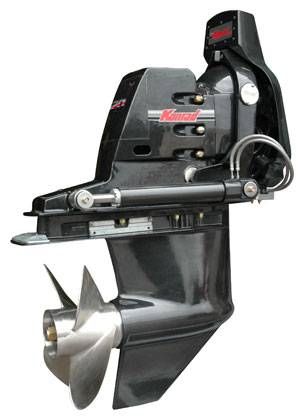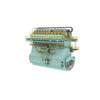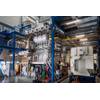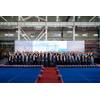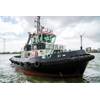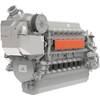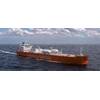by Raina Clark, from the March 2011 edition of MarineNews
Hudson, Wis., on the border of Minn., with a population just over 12,000, is home to Konrad Marine, a manufacturer of stern drives for commercial applications such as patrol boats, fishing vessels and water taxis. “We do the design right here in Hudson,” owner and founder Ken Konrad said. “I’m a mechanical engineer myself. I’m the key person in designing the drive originally and also, at this time, of all our new products coming out.”
Konrad, a local to the area, saw some of the world before returning to his stomping grounds to build his business. “After graduating from high school I went to college for a little while and dropped out. Then I became a machinist and went to a two-year trade school” in Minneapolis, Minn. After trade school Konrad went into the Navy. “I was originally stationed on an ammunition ship in the Mediterranean and Caribbean. Then I volunteered for Vietnam. I got on a tender that took care of patrol boats in Vietnam. We took care of swift boats and other patrol boats in the area. We were stationed in a little town called An-Thoy [on the southern tip of Vietnam].” Konrad said the term “town” was stretching it. An-Thoy was only a village of a few hundred people. He was stationed there from 1966 to 1967.
“I think you’ve heard of swift boats because John Kerry, who ran for president, was also on swift boats. He was actually at the same base I was two years after me.”
Konrad spent two years in the Navy before getting out and returning home. “I started the business back in 1967 and after a few years I wanted to do something more than just being a machinist. So I went back to the University of Minnesota under the GI bill and got a degree in Mechanical Engineering.”
After graduating from the University in 1973, he worked for a Minneapolis company as a manufacturing engineer. During this time he continued his own business on the side. “I still had some of my machinery from prior college and I picked up some work from steel mills and I developed the company out further doing steel mill parts.”
The Beginnings of Konrad Stern Drives
“In middle of 1976 I went full-time in my own company. I actually went from wearing a jacket and tie everyday back to wearing a set of coveralls. I did everything from janitorial to machining to sales and paying the bills. It was a year before we got our first employee and we’ve grown ever since then. Presently we’re about 45 employees.”
Konrad had his sites on more than steel mill parts. “It was about 1990,” Konrad said, “and I wanted to start something else. I wanted to get another company going and I really wanted to have a product. We started out making parts for Mercury Alpha drives and we displayed our product at the boat shows. At the Miami Boat Show several diesel manufacturers approached me about producing a heavier stern drive to go with the diesel engine. I said ‘sure, we can do that.’”
As a result, Konrad developed his own stern drive. “I think it was about 1997/98 when we came out with the 520 stern drive and we’ve been selling to the diesel commercial market ever since. Once we came out with our own drive we stopped making parts for the Mercury Alpha drives,” he said. “In the mid-90s when we were first designing the drive we looked at all the drives on the market” up to that time. Konrad said he put in the largest gears and bearings and heaviest castings he could. “Our drive is heavier than any other product on the market. Most stern drives on the market had a design life of about 400 hours back then. Some drives today are probably good to 800 to 1,000.” But Kondrad said when the 520 stern drive came out, it was designed for a minimum life of 3,000 hours. “So we were almost 10 times over what products were on the market.”
In U.S. Navy applications, Konrad said, “We have had some drives last in excess of 10,000 hours. I asked them ‘why did you run this drive so long?’ They said it was the only drive that could keep going, so they had to use the boat all the time.”
“But that’s the gist of it. We made a heavier drive with the idea of longer life and one of the design requirements was to take the torque and the impulse load that comes from a diesel engine.”
More Konrad Stern Drives
“The 520 stern drive took up to a 20-inch diameter prop. Since then we’ve added the 540 stern drive which is a smaller unit for higher speed, which accepts the maximum of a 16-inch diameter propeller. We’ve also come out with the 560 for counter rotating, dual prop, maximum 16-inch diameter propellers.”
“Very shortly we’re going to release our 680 which is a dual prop, 20-inch diameter unit. We’ve increased the upper gears now from four-inch diameter all the way up to eight-inch diameter. So we’ve not only increased the horsepower capacity of the drive, we’ve increased the life. The force on the gear tooth is dropping because of the larger diameter of the gears. Where the torpedo is we’re limited on diameter, but with the dual, counter-rotating propellers, we split the load over two gears rather than just one so we get double the life.”
“Also for the high-performance market, we came out with the Ace drive, a 540/560 drive in which we had a standoff box and we placed the transmission in the standoff box so they don’t have to move the engine. The present drive requires a reversing transmission. It does not shift, and we preferred that because of our commercial application.”
Reaching Major Customers: U.S. Navy, Hong Kong Police
Today Konrad has dealers and repair centers around the world including locations in Australia, The Netherlands, Chile, Venezuela and Europe. “As we start to get concentrations of drives we typically move into the area then develop a repair facility,” Konrad said. “Most of the time we do send an individual out to train local people on how to service the drives.”
As for Konrad Marine’s headquarters, “we used to be located in a small building in St. Paul, Minnesota and in 1987 we built this facility here in Hudson, Wis. I believe we had about 16 or 17 employees at that time and just gradually kept growing up. We’re in about 30,000 square feet right now and very packed in. We need to build a new building here shortly. We could probably easily use another 30,000 square feet. But due to the economy, we’re trying to be careful and not extend our neck out too far.”
Konrad said his company experienced major growth when the U.S. Navy became one of their largest customers, and this was spurred by the attack on the USS Cole. “At that point the Navy started to realize they had to do something to protect their ships when they were in port. A destroyer or frigate is a great ship at sea, but once it comes into port it’s only going one or two knots and is basically a defenseless ship. So the Navy had some small boats on the ships and they were mostly equipped with a stern drive that is not produced anymore. Those boats very seldom saw much over 100 hours use a year.” Suddenly the Navy wanted to launch those small boats every time a ship was close to shore, in order to guard against small approaching crafts.
“They found immediately that the drives they had [on the small boats] were insufficient for the job and would not stand up at all. So we retrofitted a few boats and it just kind of exploded from there. For about a year there, after 2001, the U.S. Navy took almost everything we produced. They converted all their RIB boats to our drives. They were really happy because they got such tremendous service out of it. One of our biggest customers even today is still the U.S. Navy.”
Another major customer has been the Hong Kong Police. Konrad explained that the Hong Kong police has five small boats built in The Netherlands, all with triple drives. “The boats were all aluminum, about 50-ft long. And they were required to intercept smugglers that were stealing Lexus and Mercedes and trying to smuggle them into mainland China.”
The drive and engines had failed on the boats. “The company that produced those drives did not stand behind the warranty. The builder out of The Netherlands said they were looking at losing $20 million in business. So they took the boats and bought different engines and they retrofitted the boats with our stern drives.”
Konrad said the vessels had to operate under very demanding conditions, at high speeds and also had to manage a lot of debris in Hong Kong Harbor. “The boats had to do a minimum of 45 mph cruising in six-ft waves and an intercept speed of 70 mph. We converted those in about 2002 and all five of those boats are still running and they’re still performing they’re job.”


